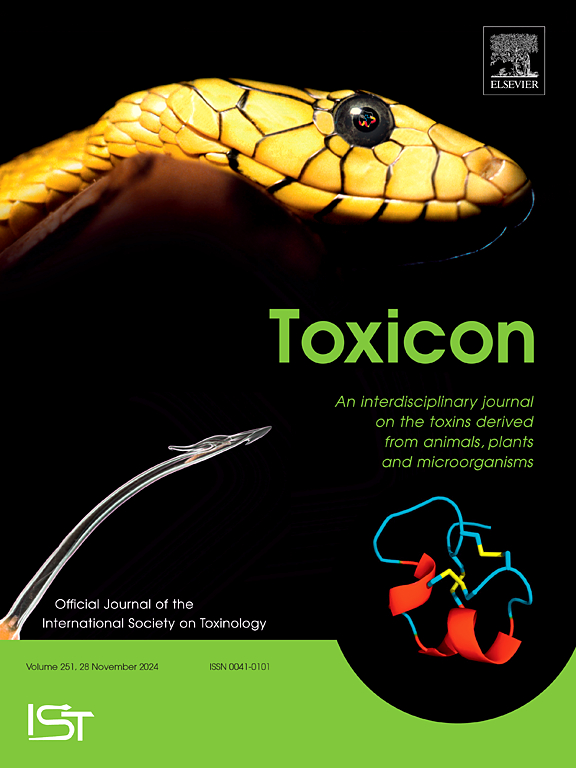The impact of the door-to-antivenom time on the resolution of coagulopathy caused by green pit viper bite—a retrospective cohort study
IF 2.6
4区 医学
Q2 PHARMACOLOGY & PHARMACY
引用次数: 0
Abstract
Trimeresurus albolabris (green pit viper) accounts for 95% of human venomous snakebites in Hong Kong and the Green Pit Viper antivenin has become the only antivenom available. Little is known about the impact of early antivenom administration on the duration of venom-induced coagulopathy. This retrospective study aimed to evaluate the impact of the door-to-antivenom time (DTAT) on the duration of such coagulopathy. Consecutive patients with green pit viper bite reported to the Hong Kong Poison Control Centre between 1 January 2012 and 31 December 2022 were included. Electronic medical records were reviewed, and the time and dose of antivenom administration were examined. The level of coagulopathy before and after antivenom was graded using the modified Snakebite Severity Scale. The primary outcome was the duration of venom-induced coagulopathy. Univariate and multivariable generalized linear regression analyses were used to evaluate the association between DTAT and the duration of coagulopathy. In total, 82 adult cases (median age 56 years, 51.2% men) were analyzed. The median DTAT was 4.2 h. DTAT was correlated with the duration of coagulopathy (Spearman r 0.426, p < 0.001), which was correlated with the hospital length of stay (Spearman r 0.357, p = 0.001). However, DTAT was not correlated with the hospital length of stay (Spearman r 0.105, p = 0.346). After adjusting for confounding factors, DTAT (adjusted regression coefficient [β] 1.73, 95% confidence interval [CI] 0.38 to 3.08, p = 0.012), pre-antivenom level of coagulopathy (adjusted β 17.08, 95% CI 3.00 to 31.16, p = 0.017), platelet transfusion (adjusted β 217.11, 95% CI 70.43 to 363.80, p = 0.004), and transfusion of fresh frozen plasma (adjusted β −175.34, 95% CI 330.90 to −19.77, p = 0.027) were significantly associated with the duration of coagulopathy. These findings suggest that prompt administration of antivenom may shorten the duration of coagulopathy.

绿蝮蛇咬伤引起的凝血病的缓解受 "门到蛇毒血清 "时间的影响--一项回顾性队列研究。
在香港,95%的人被绿蝮蛇咬伤,而绿蝮蛇抗蛇毒血清已成为唯一可用的抗蛇毒血清。早期注射抗蛇毒血清对毒液引起的凝血病持续时间的影响鲜为人知。这项回顾性研究旨在评估门到抗蛇毒血清时间(DTAT)对这种凝血病持续时间的影响。研究纳入了2012年1月1日至2022年12月31日期间向香港中毒控制中心报告的绿蝮蛇咬伤患者。研究人员查阅了电子病历,并检查了注射抗蛇毒血清的时间和剂量。抗蛇毒血清前后的凝血病变程度采用改良蛇咬伤严重程度量表进行分级。主要结果是毒液诱发凝血病的持续时间。采用单变量和多变量广义线性回归分析来评估 DTAT 与凝血病持续时间之间的关系。共分析了 82 例成人病例(中位年龄 56 岁,51.2% 为男性)。DTAT 的中位数为 4.2 小时。DTAT 与凝血病持续时间相关(Spearman r 0.426,p < 0.001),与住院时间相关(Spearman r 0.357,p = 0.001)。然而,DTAT 与住院时间无关(Spearman r 0.105,p = 0.346)。调整混杂因素后,DTAT(调整回归系数[β] 1.73,95% 置信区间[CI] 0.38 至 3.08,p = 0.012)、血清前凝血病水平(调整β 17.08,95% CI 3.00 至 31.16,p = 0.017)、血小板输注(调整后 β 217.11,95% CI 70.43 至 363.80,p = 0.004)和新鲜冰冻血浆输注(调整后 β -175.34,95% CI 330.90 至 -19.77,p = 0.027)与凝血病持续时间显著相关。这些研究结果表明,及时注射抗蛇毒血清可缩短凝血病的持续时间。
本文章由计算机程序翻译,如有差异,请以英文原文为准。
求助全文
约1分钟内获得全文
求助全文
来源期刊

Toxicon
医学-毒理学
CiteScore
4.80
自引率
10.70%
发文量
358
审稿时长
68 days
期刊介绍:
Toxicon has an open access mirror Toxicon: X, sharing the same aims and scope, editorial team, submission system and rigorous peer review. An introductory offer Toxicon: X - full waiver of the Open Access fee.
Toxicon''s "aims and scope" are to publish:
-articles containing the results of original research on problems related to toxins derived from animals, plants and microorganisms
-papers on novel findings related to the chemical, pharmacological, toxicological, and immunological properties of natural toxins
-molecular biological studies of toxins and other genes from poisonous and venomous organisms that advance understanding of the role or function of toxins
-clinical observations on poisoning and envenoming where a new therapeutic principle has been proposed or a decidedly superior clinical result has been obtained.
-material on the use of toxins as tools in studying biological processes and material on subjects related to venom and antivenom problems.
-articles on the translational application of toxins, for example as drugs and insecticides
-epidemiological studies on envenoming or poisoning, so long as they highlight a previously unrecognised medical problem or provide insight into the prevention or medical treatment of envenoming or poisoning. Retrospective surveys of hospital records, especially those lacking species identification, will not be considered for publication. Properly designed prospective community-based surveys are strongly encouraged.
-articles describing well-known activities of venoms, such as antibacterial, anticancer, and analgesic activities of arachnid venoms, without any attempt to define the mechanism of action or purify the active component, will not be considered for publication in Toxicon.
-review articles on problems related to toxinology.
To encourage the exchange of ideas, sections of the journal may be devoted to Short Communications, Letters to the Editor and activities of the affiliated societies.
 求助内容:
求助内容: 应助结果提醒方式:
应助结果提醒方式:


